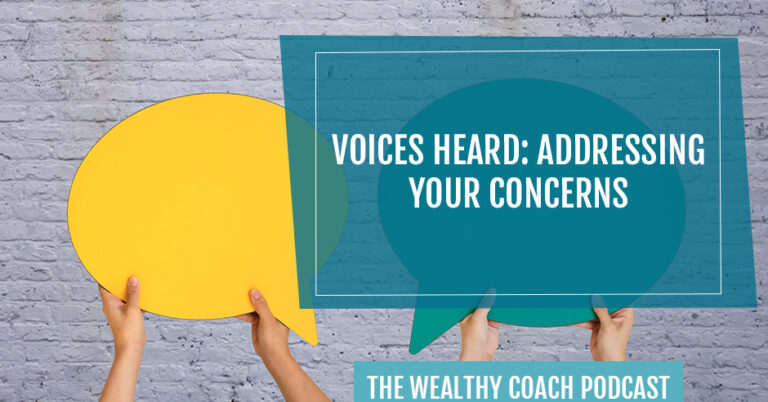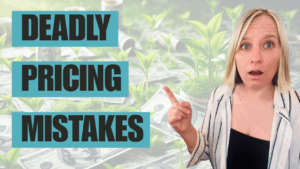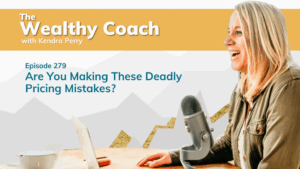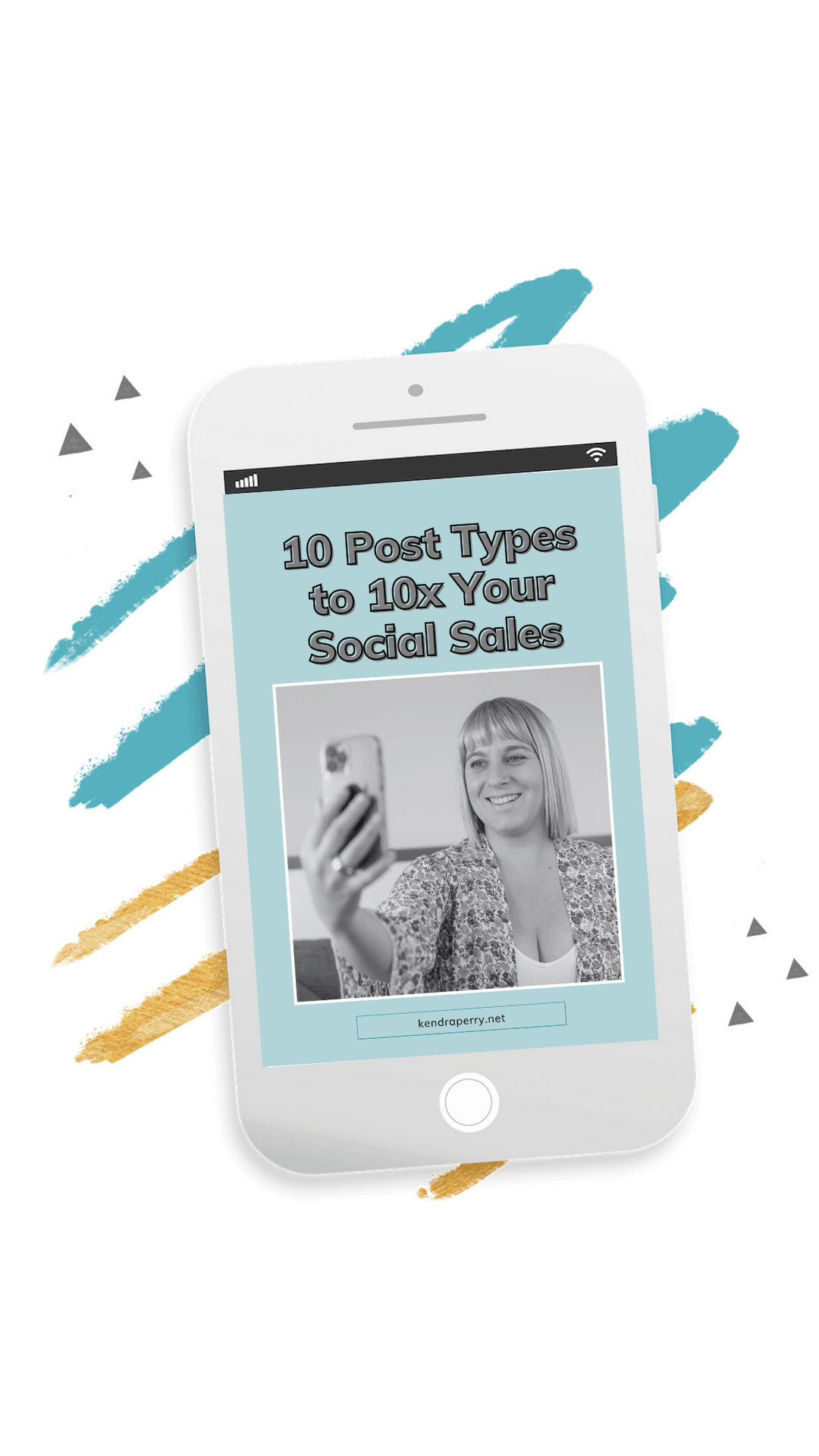As a coach, what are your struggles in your niche? How do you face them? In this episode, Kendra Perry discusses how she addresses the concerns of coaches to help you become a wealthy coach. Pitching, personal branding, pricing, and reducing anxiety as they reach their menopausal stage are some of the areas Kendra addresses. Her wealth of experience and wisdom will open your doors to the coaching space. So, join Kendra Perry and become The Wealthy Coach with her today.
DM ‘biz audit’ to @kendraperryinc on Instagram Website to get your free biz audit.
Give this podcast a 5-star review. Rate this Podcast Website.
—
Listen to the podcast here
Voices Heard: Addressing Your Concerns
As always, I’m excited to be with you here. At the time of this episode, it’s mid to late November 2023. I got back from a four-day retreat at this beautiful retreat center on the lake. I’ve been there before, me and my partner Ryan, I believe for our anniversary once, or maybe for his birthday. We stayed there once because you can rent the rooms when there’s not an event going on, but typically, they host these various retreats.
I wanted to go to a Joe Dispenza retreat. The one that was being offered was in Orlando, Florida, which is on the opposite side of the continent for me. I was not feeling the travel because as you may or may not know, I live in a pretty remote town. I can’t just hop on a plane. It takes me about at least three hours to get to the airport. I wasn’t feeling the drive and a long plane ride.
I was like, “I’m going to check out this little retreat center that’s about one hour drive from where I live and see what they have going on.” They had a bunch of different things going on. I ended up settling on this one called Radical Rest. Not necessarily because I felt like I needed to rest, but because honestly, I rest a lot. I lead a relatively low-stress life. I don’t have kids. I work 20 to 25 hours a week. I’m not someone who packs out my schedule. I like to chill. I’m pretty introverted.
I love being at home, doing nothing. I thought it would be nice to get a nice room on the lake with a view. There was breathwork, meditation, yoga, and sound healing. I was like, “That all sounds good.” That’s what I did. It was interesting. It was way different than I thought it would be. There was this amazing facilitator. It had us analyze our relationship with rest and being busy. At first, I was like, “I’m not relating to this,” because as I said, with everything I told you, I have a low-stress life. I’m not afraid to rest. I don’t like to be busy.
Something that came up for me was this interesting relationship I have with boredom. It made me think about like, “What is boredom? What a weird word. It’s like nothing to do.” There’s a negative attachment to that word like, “I’m bored. I don’t want to be bored.” I hate being bored. I avoid being bored at all costs. What if being bored was a good thing?
Truthfully, I’m always doing something. I’m never just sitting there, listening, and resting. Usually, if I’m sitting around my house, I’m reading, watching reality TV, coloring, or doing a chore around the house. When I think about what rest means to me and when I visualize what would it look like, what I think about is having a nice hot drink in my hand, sitting in a comfy chair, and looking at the view. To me, that’s rest.
That’s something I always want and I always fantasize about, but I rarely ever do it even though I have the time and the space to do so. I thought that was interesting. What I walked away with is that maybe I need to lean a little bit more into my boredom and not try to watch, listen, or read when I’m sitting there. What if it was okay to feel bored and if I could sit there with my drink and look at the view, listen to the birds, and have that be okay? I thought that was interesting.
Another thing that the facilitator said at the end stuck with me and I totally agree with it and maybe it’ll resonate with you too. I’m almost done talking about me before we dive into this episode, but she said when she was giving us a list of tips and integrations to walk away with as we were leaving, “Reject self-improvement and embrace self-acceptance.” That resonated with me because if you’re like me, you’ve read all the self-help books and I’ve spent the better part of a decade trying to fix myself.

What I’ve realized in the past couple of years is that I’m never going to be fixed and I don’t think I need to be fixed. What this journey is about when we talk about personal development and inner work is self-acceptance and accepting ourselves. I can’t say that I accept myself. A lot of us struggle. There’s always something wrong with us. There’s always something we want to fix, “We’re too skinny, fat, slow or fast. We’re too much of this. We’re too little of this.” We’re critical of ourselves. I’m no different. I struggle with this too.
What I need to work on going forward is working more on self-acceptance. That’s going to be challenging, but I also think it’s going to be well worth it. I went in with no expectations. I wanted to do something different like spend a few days in a beautiful place, maybe meet some cool new people, and eat some good food all of that happened. The food was amazing. The people were amazing. It was great. I walked away with something I didn’t expect. That was to lean into my boredom and work on self-acceptance. I don’t know if that resonates with you, but you can shoot me a message on Instagram @KendraPerryInc. if you have any comments or if that resonates with you, I always love to hear from you.
For this episode, I was wondering what to write. Usually, I’m a little bit more prepared. I plan out things in advance, but I was like, “I don’t know what I want to make this episode about,” then it occurred to me that I could make the episode as much about you as possible. In a lot of my email sequences, when people opt in for a freebie, I always send them an email usually three hours after they receive the freebie and I say, “I wanted to make sure you receive this. Reply to this email and let me know. If you could also let me know what your biggest struggle with,” I insert whatever the topic of the freebie that I sent them.
We get quite a few replies. I save all of these. I come back and I look at them. I use them for inspiration with my messaging, but I thought it would be fun to go through several of them and address them right here on the show. if you are someone who has sent in one of your struggles or concerns into email, then maybe you’re going to get your struggle or concern addressed during this episode. I thought that would be fun because a lot of these struggles are very common. There’s a good chance that even if this isn’t your struggle, you resonate with it or you’ve struggled with it as well.
The first one that I got is, “I don’t know what to post that seems authentic and doesn’t come off like I’m trying to pitch.” This would’ve been a response to one of my social media content guides. I love this because this is a struggle that many coaches have. We struggle to be ourselves online and then we don’t want to come off as pitchy or salesy. This is a topic I’ve covered a little bit on the show before, but it’s worth speaking about it again.
Pitching
There is nothing wrong with coming off like you were trying to pitch something. Why do we feel like that is a bad thing? We are businesses. Imagine you went into Walmart. You got in there and Walmart was like, “What’s up? Do you want to get a coffee? Do you want to be friends? Tell me about yourself.” Walmart was like trying to be your friend, getting to know you, and you were like, “That’s cool. Walmart’s cool.”
All of a sudden, weeks, months, or whatever into your relationship with Walmart, suddenly, Walmart was like, “I want you to buy my handbags and this makeup.” You were like, “What? Walmart, I thought we were friends. I thought we were buds. This is confusing.” Think about that. Think about how fucked up and weird that would be.
Something that you need to embrace is the fact that you’re a business and no one is ever going to shame a business for selling. You would never go into Walmart and be like, “Screw you, Walmart. Why are you trying to sell me all this crap? This is ridiculous. Give me some free crap.” No one would do that. I find it funny.

When we come online as business owners and we ultimately have something to sell, we feel that there’s something wrong with that. There’s nothing wrong with that. I recommend that we pitch constantly, that we’re pitching all the time. I’m not talking about being in people’s face, being directly promotional every day, all day. I’m not saying that, but I’m saying we are always pitching either directly or indirectly. This is important. There’s nothing wrong with pitching. You will quickly learn if you consume my content.
You may have been on this show and reading this for a little while. You might follow me on Instagram or wherever. You may not notice because truthfully, I’m pitching to you all the time. I’m either directly promoting my program. At the beginning of this episode, I have a little pre-roll that tells you about the Health Coach Accelerator and how to apply. At this point, I’m talking about my program Health Coach Accelerator. I’m always peppering it in.
Very quickly, when you’re following me, you know that I’m a business coach. I help health coaches. I have a program called Health Coach Accelerator on offer. There’s nothing wrong with that. I’m still out there providing all kinds of value and free content. I’m very generous, but I’m always trying to sell you something because I’m not here to be a charity and give away free content. Yes, I love to serve. I like being on social media. I like providing value, but ultimately, I’m here to help people transform. That only happens inside my program. My program is amazing. You’d be silly not to sign up for it.
We have to get over this whole thing where like, “I don’t want to come off like I’m trying to pitch something, because like why is that bad? Why is there something wrong with that?” You do have something to pitch and sell. Hopefully, you believe in what you do. You think what you do and what you offer is awesome and that people could benefit from it. Why would you not want to pitch that?
In terms of, “I don’t know what to post that seems authentic.” I get this. A big struggle with social media is learning how to be yourself. When we talk about personal branding and building a brand that people connect with, it truly is about embracing who you are and allowing that to come through in your content.
Personal Branding
A great exercise that you can do is sit down and journal a little bit about your personality. What’s your sense of humor? How do you talk? Do you talk fast? Are you chill? Do you have like a surfer vibe? Are you rigid? Start to brainstorm all the pieces of your personality. If you get stuck with that, you can ask a friend or a family member, someone who knows you and try to figure out what are the aspects of your personality that are the most dominant. You want that to come through in your content.
My brand is a piece of my personality. It’s not all of me. I want to be clear with that. The way that we show up online will never be all of who we are. It can’t be. We are all intricate beings with intense crap going on in our lives. There are things about me that you’re never going to know. I keep certain things private, but how I come off online is how I am. I’m blunt. I’m a no-BS type of person. I’m transparent. I’m excitable. I’m down to Earth.

This is how I am in person. It’s not that different than how I show up online. If you met me in person, you’d be like, “You’re exactly how you are online.” That would be a great compliment. Know that we don’t need to try to be authentic. We just need to be, but that being can be challenging because sometimes we don’t know how to be ourselves, especially when we’re trying to translate that into an online format. Especially for those of us who maybe didn’t grow up with social media where we’re not used to curating our lives online.
This is an invitation for you to learn about yourself and try to be yourself, but also give yourself grace and be okay with the fact that it’s going to feel a little weird in the beginning and it may not come off as exactly authentic in the beginning. That’s okay. I didn’t come off as authentically myself in the beginning either. I was very awkward, uncomfortable and monotone. It’s normal. It’s part of it. It’s okay. Be yourself. There’s nothing wrong with pitching. That’s the biggest take-home I can give you with this one.
Pricing High
The next one is, “I struggle with feeling like I’m taking advantage by pricing high. That being said, I’m planning on offering a program to give all my twenty-plus years of experience, plus degree-level training. It feels very alien to me.” This is another one. This is another thing that is deeply ingrained in our mindset. Why would we be taking advantage if we were pricing high? Think about that. Are you forcing someone to sign up with you? Are you forcing someone to do your program? No, it’s always a choice.
When people decide to pay something, it’s their choice. I believe in pricing where you are at. That’s going to be different for everyone. If you were someone who doesn’t have a lot of experience and you’ve never coached someone before, then I don’t think you should be charging someone $5,000. Start where you’re at. In your case, twenty-plus years of experience, plus degree-level training. I don’t know exactly what it is that you do, but let’s say that twenty years of experience is therapy and you’re going into coaching, that translates over.
You can probably start by charging a little bit higher, but obviously, you see your worth because you said, “My twenty-plus years of experience plus degree-level training,” that’s big. Think about all the time and money you have invested into your expertise. You deserve to charge high. You’re not taking advantage. You’re only taking advantage when you don’t deliver on what you promise. That is where you take advantage, but you’re not taking advantage by pricing high because there’s no agreement in pricing high. If somebody becomes your client, they are agreeing to pay that price.
The other thing we have to keep in mind here is our perception of what is pricing high is different for everyone. What you think is high, someone else might think is a great deal. What you think is low, I guarantee someone else is going to think is too high. You will get the price objection at every single price point. I once had a woman tell me that $27 for a workshop that I was doing was too expensive.
My advice with pricing is to start with a price point that you feel comfortable with. I always recommend that we aim towards high ticket pricing of at least $1,500 or more for a program. If you don’t want to start at $1,500, it’s not a big deal. Why does it matter? If you want to start at $500, go for it. Do that. If you can say $500 without your voice cracking and you can say that confidently, then start at $500.
It’s not where you’re going to stay. Make the plan that, “With every three clients I get, I’m going to raise my price by a percentage or a dollar amount.” That’s what I did early on in my business. I continually increased my price with every few clients that I worked with. I started at a $400 program that eventually became a $6,000 program. That happened over a couple or a few years. I can’t remember exactly.
The great thing about pricing low is you will quickly learn that it’s too low. That’s the thing about it. It’s not a bad thing to have that experience where you price something too low and you quickly realize, “I’m giving away way too much. I’m working way too much for this amount of money. I’m essentially paying myself a minimum wage.”
It’s not a bad experience to have because then it gives you the confidence to raise your price because you’re like, “I cannot offer this for $400.” The fact that I offered the program that I offered for $400 was crazy, but at the time I felt like it was insanely high. You are not taking advantage. The only way you are taking advantage is when you don’t fulfill the promise, the price for a certain program and you don’t deliver on that.
You putting a price point out ever out there and having someone in agreement decide to pay it to work with you, it’s not taking advantage. You have twenty-plus years of experience and degree-level training. Think about the time it would take someone to be able to do that. Your expertise is worth it. Start where you’re comfortable with. It’s okay. You’re not going to stay there forever. You can increase it with time.
Women Over 40
Let’s move on to the third one. The next struggle is, “How do I define how to help women over 40 as I help them with many things like reducing anxiety or weight, gain confidence, feel energized, gain control over their menopausal symptoms?” When we’re working with women over 40, it’s important to define the different phases because we have women in their 40s who are in that perimenopausal phase. They’re not in full menopause. They’re still getting a cycle. Hormones are inconsistent.
They’re probably getting all those perimenopausal symptoms versus a woman maybe in her 50s who is going into full menopause. It’s going to look a little bit different. Probably the way that you help them is going to look a little bit different too. I know with perimenopause, there are a lot of different symptoms going on, but perimenopause in itself is a problem that can be solved.
My hesitation with perimenopause is making sure that your people know what it is. Not all women know what perimenopause is. I only learned what it was a few years ago. I know people who have a perimenopause niche and they’re very successful. You mentioned at the end, “Gain control of their menopausal symptoms.” Menopausal symptoms in itself is a big problem. Women know what menopause is and a lot of women struggle with that.
It comes with a lot of different symptoms like anxiety, weight gain, loss of confidence, and low energy. Your niche could be, “I help women 50-plus gain control over their menopausal symptoms so they can insert the outcome that they want.” Within your messaging, you will speak to things like having anxiety, not feeling like yourself, gaining all this weight and not being able to lose it. It’s a great niche.
I know it can be confusing because there are certain conditions that we could go after as a niche where there are many different symptoms involved. An example would be any thyroid issue. There are going to be things like weight gain, hair loss, and low energy. It’s very common with thyroid symptoms. Being hypothyroid is a diagnosis that people want to recover from.
It’s okay if the condition that you help with has many symptoms, make sure that the condition that you’re helping people with, people know that they have. Women know they’re in menopause. They know that they’re in perimenopause. They know that they have a thyroid condition or they suspect they do. That’s fine. You can go after a condition with multiple symptoms. You want to make sure the person has awareness around it.
“My biggest problem with pricing is an inability to predict how many services my client will ask for me once the program starts. What is the reasonable price, including my education, effort, expense and my time investment to create for a client? A lot of effort given to the client behind the scenes is not visible in homeopathic practice.” Another one about pricing. Pricing is a big one. Everyone struggles with this.
How I teach my students to sell is to create a program. It’s a program that looks the same for everyone. When you say, “I don’t know how many services my clients will ask for me,” you’re not going to give them the option to ask. You are the expert. If you’re going after someone with one problem, then you will know what they need. We don’t want to put that power into that of the client because they don’t know what they need.
The reason why you might be struggling is because perhaps you don’t have a niche and you are talking to everyone. You are offering general services. In which case, it’s impossible to price properly because you never know what people are going to need or want from you versus if we niche in one specific problem. I’ll use the example of migraines. Let’s say you help some demographic of people get rid of their migraine headaches. Essentially, you create a program that is based around you solving their migraines. It sounds like you’re a homeopathic doctor. Part of your method that helps them get from A, B to C from migraines on the regular to fewer or infrequent migraines is with homeopathy. That is your method.
Essentially, what you’re going to do is create this program that always looks the same. Meaning that, there is no extra services. They don’t choose. You’re like, “This is the migraine program. This is how I help you solve your migraines with homeopathy.” People buy it, come in, and go through that step by step. You’re going to put it into one program then anything personalized essentially happens in the coaching sessions. Whether that’s one-on-one, group or a combination of both. I can’t tell you what is a reasonable price because it’s very subjective.
As we talked about before, what I think is expensive, you might think is cheap. What you think is cheap, I might think is expensive. It’s a little bit different for everyone, but keep in mind your business. You need to account for the time behind the scenes. This is something that we can figure out over time of working with clients. You can estimate it in the beginning if you’re new.
What you can do is figure out, “Behind the scenes, how much time do I need to spend?” Whether it’s going over client cases, maybe analyzing test results, creating protocols, answering emails, the notes that you send to them after the appointment, or the prep that you do before the appointment. You do need to figure out what this is because you need to be getting paid for your time. We’re not here to work for free.
This is a big part of how a lot of coaches screw themselves over because they don’t account for the time that they spend behind the scenes. That’s how a lot of practitioners end up paying themselves a minimum wage. Choose a price point that you feel comfortable at and know that you’re going to increase it over time. I wouldn’t worry too much about it. If it’s too low, you’re going to quickly find that out.
You will quickly learn that, “I way underpriced myself. I’m working for free. I’m working for $10 an hour when all is said and done.” You will learn that very quickly and there’s nothing wrong with that. A lot of us have that experience and it’s not a bad experience to have because it makes you feel confident in raising your prices.
A question I have about a signature offer is, “As a coach, how can I determine how many sessions my clients need to succeed in the transformation? I’m a beginner dietician. Even though I have an education, for nutrition, I don’t think I can make a transformation in ten sessions like many professionals offer. Part of me feels that the other practitioners cannot promise that either.”
I want you to think of it in this way. When we’re thinking about helping clients get a transformation, it’s not just about the sessions. It’s also about the education we provide, the support, the accountability, and all these different things. You’re going to have to choose a niche because dietician services are not a niche and you will struggle to sell that because it’s not a problem that people are seeking to solve. Being a dietician using nutrition is an amazing method in which you can help with all kinds of different problems.
The first step will be niching here, but this is where a lot of people get stuck. This is how I like to frame it. Health is ongoing. It’s not like someone would do ten sessions with you, and they would be healed. They could go off into the world and not think about it ever again. It’s a journey and a lifestyle change. We’re not always necessarily getting people the full transformation in the time that we’re working with them.
For a program, a signature offer, I typically recommend 3 to 4 months. Four months if you’re running labs. If you’re not, 90 days is great. A lot of students will say, “Ninety days are enough.” They’re not going to get the full transformation within that timeframe, but that’s not the point. The point is to show them how to do it and the lifestyle change, to teach it to them and get them implementing it so that they can continue to execute it over time.
If you come into Health Coach Accelerator, you’re in there for 6 months. Are you going to have a 6-figure business after 6 months? No, but you’re going to have the framework for your business. You’re going to have your sales and marketing plan. You’re going to have your offer built. You’re probably going to be enrolling some clients, but you still have to go out there and execute it. What we’re doing with this extra offer is showing them how to get a particular result. If we use the migraine example, you are showing them within 90 days what they need to do to be migraine-free.
You’re showing them how to change their diet, sleep properly, manage their stress, detox from toxins and chemicals, exercise, or whatever it is that you believe they need in order to get rid of those migraines. Will they have a reduction within 90 days? They might. They probably will. They’re probably going to see some improvement. Are they going to be fully migraine-free? Maybe not. That’s okay. That’s not the point. You’re showing them how to get the result.
You’re teaching them everything they need to know to move towards a result. Think of it like the intro program. At the end of those 90 days, what you’re going to do is give them the option to continue working with you. If you come into HCA, you’re going to be with us for six months. You’re going to get the live support for six months. At the end of six months, we’re going to invite you into our graduate program. If you want to continue working with us, accessing support, getting coaching from us and getting some new content, then you’re going to stick around. If you feel complete and you’re like, “I can do this on my own. I don’t need coaching,” then you’ll be done. That’s totally cool.
The final one that I’m going to go through is a good one, “It’s always been a struggle to know what to post even though I have downloaded previous example scripts to help. I struggled to translate them into my niche-offering content. When I finally have inspiration or figure out what I want to post, it takes me so long to create either a real Carousel or even captions that go with the picture. The idea of posting almost daily would be a full-time job.”
This is what I can offer you in terms of this struggle. I highly recommend that you batch or chunk content and that you use something like ChatGPT as often as possible. Know that when it comes to social media, the goal is not perfection. A lot of the stuff I post is not perfect and doesn’t land with people. It’s super common. The goal is to post consistently and get better over time. You’re saying that it’s taking you long, “Why is it taking you long? Is it because you’re lacking ideas or you’re trying to make it completely perfect? What is the actual reason?”
If you’re lacking ideas, you can use ChatGPT. You can put your niche into ChatGPT and ask it to come up with content ideas for you. You can also ask your audience if you have an audience. You can pull them on Instagram. You can ask them in your emails. You can ask people on what they want to learn about. A great example is when people follow me on Instagram, we reach out, welcome them, and say, “We want to reach out like a human. How did you find us?”
Usually in that conversation, we’ll ask them if they’re a health coach, what their biggest struggle is, and what they would like to see in our content. That’s where I get a lot of my ideas from. You can also use ChatGPT if you don’t currently have an audience. You can also use ChatGPT to write your content for you. This is something I cover extensively in Health Coach Accelerator. I teach my students how to use AI. You can use it to help you write it. You can grab old posts that did well and have ChatGPT rewrite and reformat them.
Know that you don’t need to post every day. I recommend 3 to 5 times a week. If you’re running ads, you can post less. Maybe ads would be a good option for you so you don’t have to post as much on social media. What helps me to be consistent with my content is batching. I don’t wait for inspiration or figure it out. I plan everything in advance. I sit down and plan out what I’m going to do for my content, and then I write it all. I do it all in 1 day or 2.
You can also do chunking, which would mean that you would sit down and plan. The next week you would write, plan, or film the content, and then maybe the next week you would schedule it. That’s called chunking. You can do that as well. This is a cool thing. Once you have posted enough content, you don’t need to create much new content. Here’s a little secret I’m going to let you in on.
A lot of the stuff I post on Instagram isn’t new. Maybe every month, there are 2 or 3 posts that are new pieces of content. Essentially what I’m doing is redesigning and rewriting old pieces of content. There have been times when I’ve been sick or I’ve gone through something where I can’t post. I repost all pieces of content and don’t change anything. Think of it as you’re working towards building this bank of content that you can reuse and repost to the point where you don’t have to do much with your content.
For some of those examples or scripts that you’ve used in the past, you can put those into ChatGPT and ask it to utilize that script to write a piece of content for you. You want to let it know who your target audience is and what your voice is, essentially what you want it to sound like. When I talk to ChatGPT, I say to write it in a blunt, no BS, and playful voice because that’s how I talk. There are a lot of things out there that can make it a lot easier for you.
In terms of the design, I would keep it very simple. Go into Canva, create five branded templates for Carousels or whatever, and cycle through them. That can give you that consistent visual feel. You don’t need to have anything overly designed or fancy. I hope this was helpful. If you have a struggle that you’d like me to cover on the show, you can feel free to reach out to me on Instagram at @KendraPerryInc. Let me know. It’s something I could cover in the future. I hope you enjoyed this episode. I hope you have a great day and I’ll see you next episode where I help you become wealthy AF.
Important Links


![[BEST OF] A Cautionary Tale About Your Niche](https://kendraperry.net/wp-content/uploads/2025/05/BEST-OF-A-Cautionary-Tale-About-Your-Niche-300x169.png)



